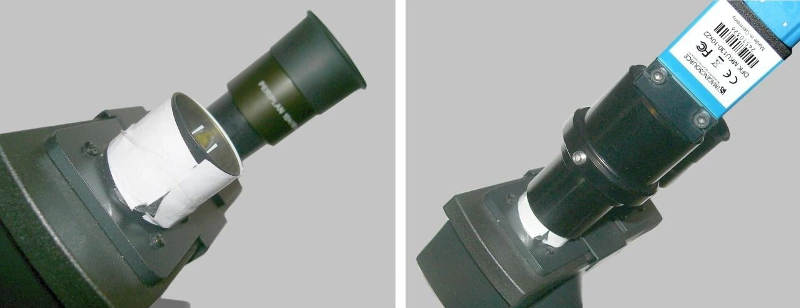Mikroskopkamera: Universellen Verwendbarkeit?
Veröffentlicht am 17. August 2016 von TIS Marketing.
Ursprünglich veröffentlichter Artikel in der Fachzeitschrift Mikroskopie (Jahrgang 3, Nr. 1/2016, S. 37-51) von J. Piper und M. Torzewski. Gegliedert in Abschnitt: 1, 2, 3, 4, 5, 6, 7, 8, 9, 10 und 11.
Technische Realisierung einer universellen Verwendbarkeit
Der auffallend kleine Lichtdurchlass an der Frontseite des Kameramoduls erinnert im Durchmesser an eine eng geschlossene menschliche Pupille und an die Öffnung einer sog. Lochkamera. Hinter diesem Lichtdurchlass befindet sich im Inneren der Kamera ein ZoomLinsensystem mit Autofokus. In Zoomstellung 1x beträgt die Brennweite dieses Linsensystems lt. Herstellerangaben 5,3 mm, entsprechend einem Kleinbild-Äquivalent von 35 mm (Bildwinkel: 64°). Diese optische Auslegung (enge Eintrittspupille plus geringe Brennweite) gewährleistet im Zusammenwirken mit dem relativ kleinflächigen Chip eine maximierte Tiefenschärfe. Durch Lösen der Imbus-Schraube kann das herstellerseitig mitgelieferte Okular so weit aus dem Tubus herausgezogen werden, dass sich eine vignettierungsfreie Ausleuchtung des abgebildeten Sehfeldes ergibt und der Augenpunkt des Okulars mit der Austrittspupille des in die Kamera integrierten Objektivs möglichst übereinstimmt; in der Regel genügt ein Herausschieben des Okulars um etwa 1 cm, gerechnet ab seiner tiefsten Stellung.
Wenn ein Mikroskop mit einem Tubus für 30 mm-Okulare zur Verfügung steht, kann folglich das mitgelieferte Okular incl. Kamera anstelle eines Beobachtungsokulars in den TubusStutzen gesteckt werden. Sofern der Okulardurchmesser des Mikroskops geringer ist, kann das mitgelieferte Okular nicht verwendet werden. Dennoch kann auch in solchen Fällen oftmals eine brauchbare Kameraadaptation erreicht werden. Zu diesem Zweck ist das zur Kamera mitgelieferte Okular zu entfernen. Der linsenlose Tubus der Kamera muss nun stattdessen mit dem Originalokular des jeweiligen Mikroskops bestückt bzw. der KameraTubus über den Okular-Stutzen des Mikroskop-Tubus geschoben werden. Gegebenenfalls kann um den Mikroskop-seitigen Okularstutzen eine Papiermanschette gelegt werden, damit der Kameratubus achsgerecht und passgenau, ohne zu verkanten aufgeschoben werden kann (Beispiel in Abb. 3).

Falls der Außendurchmesser des Okulars höher liegt als der Innendurchmesser des KameraTubus (33 mm), muss auch der Kamera-Tubus entfernt werden. In diesem Fall kann der Kamera-Body als solches in passendem Abstand, entsprechend dessen Austrittspupille, dem Okular aufgelegt bzw. über dem Okular befestigt werden. Bei Erfordernis muss ein mechanisch geeigneter Adapter vom Anwender selbst "gebastelt" werden; denn der Hersteller bietet z. Zt. nur das erwähnte Brillenträgerokular und den dazu passenden Kamera-Tubus an.
Falls ein trinokularer Fototubus mit C-Mount-Anschluss zur Verfügung steht, kann ein zum Lieferumfang gehörender Okularstutzen mit C-Mount-Gewinde zum Einsatz kommen. Auf diese Weise kann das mitgelieferte Okular mitsamt Kamera in den am C-Mount-Anschluss eingeschraubten Stutzen geschoben werden.
